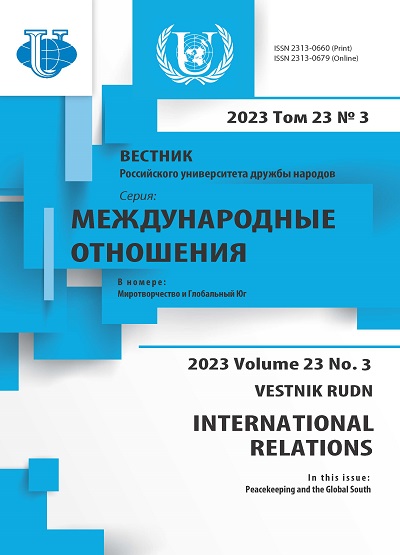Assessing India - United States Security Agreements: A Critical Analysis
- 作者: Nisar R.D.1
-
隶属关系:
- University of Sargodha
- 期: 卷 23, 编号 3 (2023): Peacekeeping and the Global South
- 页面: 536-546
- 栏目: 国际安全
- URL: https://journals.rudn.ru/international-relations/article/view/36156
- DOI: https://doi.org/10.22363/2313-0660-2023-23-3-536-546
- EDN: https://elibrary.ru/BXYWHE
如何引用文章
详细
Asia is now a central part of world politics, where the interests of a number of global and regional actors have collided, including India, China, Japan, the United States and Russia. With the collapse of the socialist bloc and the end of the Cold War, the U.S. embarked on a new security policy, changed its priorities, promoting a new balance of power and defining a new role for itself in the post-bipolar world. India, on the other hand, has strengthened its position in the Asian region thanks to its rapid economic growth, huge domestic market, modernization of armed forces, and practice of democratization. Given India’s transformation and the strategic importance of the Indian Ocean and its maritime transport routes, Washington has become interested in strengthening ties with New Delhi. As a result, India - U.S. relations are moving from the estrangement of the past to the strategic engagement of the present. Since 2004, when the document entitled “Next Step towards Strategic Partnership” was adopted, the two countries have been experiencing a phase of deep strategic convergence. This is particularly true in the area of security and defense. In the present study the author argues that Indo-US defense agreements stimulate India’s offensive power, while negatively affecting regional security in South Asia and especially Pakistan’s security. In the milieu of research methodology, the author uses the methods of content analysis, event analysis, and problem-chronological method.
关键词
作者简介
Rana Nisar
University of Sargodha
编辑信件的主要联系方式.
Email: ranadanishnisar@gmail.com
ORCID iD: 0000-0002-1354-5144
PhD (International Relations), Visiting Lecturer, Department of Politics and International Relations
Sargodha, Pakistan参考
- Abbasi, R., & Khan, Z. (2020). Nuclear deterrence in South Asia: New technologies and challenges to sustainable peace. Abingdon: Routledge.
- Abbasi, S. Y., & Nisar, R. D. (2022). Two angry-birds of South Asia & balance of power: (An Appraisal). Webology, 19(3), 3878-3890.
- Ahamed, M. (2021). A matter of trust: India - US relations from Truman to Trump. Noida: HarperCollins Publishers India.
- Babar, S. I., & Mirza, M. N. (2021). Indian strategic doctrinal transformation: Trends and trajectory. Journal of Security and Strategic Analyses, 6(2), 79-100.
- Edelstein, D. M. (2019). The persistence of great power politics. Texas National Security Review, 2(2), 117-120. Retrieved from https://repositories.lib.utexas.edu/bitstream/handle/2152/74827/TNSRVol2Issue2_Edelstein.pdf?sequence=2&isAllowed=y
- Einhorn, R., & Sidhu, W. P. S. (2017). The strategic chain: Linking Pakistan, India, China, and the United States. Arms Control and Non-Proliferation Series Paper, (14), 1-68. Retrieved from https://www.brookings.edu/wp-content/uploads/2017/03/acnpi_201703_strategic_chain.pdf
- Ganguly, S. (2016). Deadly impasse: Indo-Pakistani Relations at the dawn of a new century. Cambridge: Cambridge University Press.
- Hayat, M. U., Zaid, A., & Shahzad, F. (2020). Strategic uncertainty in India’s nuclear doctrine: Collusive threat, implications for Pakistan. Global Political Review, 5(2), 57-68. https://doi.org/10.31703/gpr.2020(V-II).06
- Hussain, M. (2017). Impact of India - United States civil nuclear deal on China - Pakistan strategic partnership. Journal of South Asian Studies, 5(1), 13-25.
- Joshi, S. (2020). How terrorist actors in Pakistan use nuclear weapons for political influence. Asian Security, 16(2), 221-242. https://doi.org/10.1080/14799855.2019.1582522
- Khan, H. U., & Khalid, I. (2018). Indian Cold Start doctrine and Pakistan’s policy response. Journal of the Research Society of Pakistan, 55(1), 325-341.
- Khan, Z. (2013). South Asian security structure: New technologies and nuclear deterrence. Strategic Studies, 33(3/4), 85-108.
- Khattak, M. U. R. (2020). The Indian Army’s Land Warfare Doctrine 2018: A critical analysis. IPRI Journal, 20(1), 105-134. https://doi.org/10.31945/iprij.200105
- Ladwig III, W. C. (2008). A Cold Start for hot wars? The Indian army’s new limited war doctrine. International Security, 32(3), 158-190. https://doi.org/10.1162/isec.2008.32.3.158
- Madan, T. (2020). Fateful triangle: How China shaped U.S. - India relations during the Cold War. Washington, D.C.: Brookings Institution Press.
- Mahrukh, K. (2017). Growing India - US strategic cooperation: An analysis. Journal of Strategic Studies, 37(4), 97-117.
- Mearsheimer, J. J. (2001). The tragedy of great power politics. New York: W.W. Norton.
- Narang, V. (2018). India‘s nuclear strategy twenty years later: From reluctance to maturation. India Review, 17(1), 159-179. https://doi.org/10.1080/14736489.2018.1415289
- Ramaswamy, M., & Shivaswamy, A. (2018). India’s Logistics Exchange Memorandum of Agreement (LEMOA): A dysphoria in disguise. International Area Studies Review, 21(3), 271-286. https://doi.org/10.1177/2233865918761922
- Rosen, M., & Jackson, D. (2017). The U.S. - India defense relationship: Putting the foundational agreements in perspective. CNA, 1-50. Retrieved from https://www.cna.org/archive/CNA_Files/pdf/drm-2016-u-013926-final2.pdf
- Samuel, C. (2007). Indo-US defence cooperation and the emerging strategic relationship. Strategic Analysis, 31(2), 209-236. https://doi.org/10.1080/09700160701391159
- Sharma, G. D. (2012). Indo-U.S. defense cooperation. New Delhi: Vij Books India Pvt Ltd.
- Shaza, A. (2021). India’s acquisition of the S-400 air defense system: Implications and options for Pakistan. Journal of Indo-Pacific Affairs. Retrieved from https://www.airuniversity.af.edu/JIPA/Display/Article/2743750/indias-acquisition-of-the-s-400-air-defense-system-implications-and-options-for/#:~:text=India's%20acquisition%20of%20the%20S-400%20air%20defense%20system%20will,from%20this%20air%20defense%20system
- Shida, W. (2019). The challenge of India - US security cooperation to India’s tradition of strategic independence. Contemporary International Relations, 29(3), 46-67. Retrieved from http://www.cicir.ac.cn/UpFiles/file/20200228/6371847869381966374066448.pdf
- Singh, B. (2019). Indo-US new strategic bonhomie in the 21st century. The Journal of Political Science, 34(1), 1-11. Retrieved from http://ps.gcu.edu.pk/wp-content/uploads/2020/04/1.-Indo-US-New-Strategic-Bonhomie-in-the-21st-Century-by-Balwinder-Singh.pdf
- Yusuf, M. (2018). Brokering peace in nuclear environments: U.S. crisis management in South Asia. Stanford: Stanford University Press.








